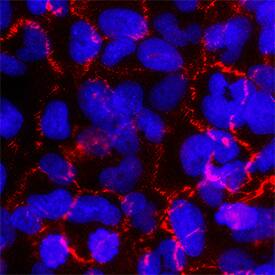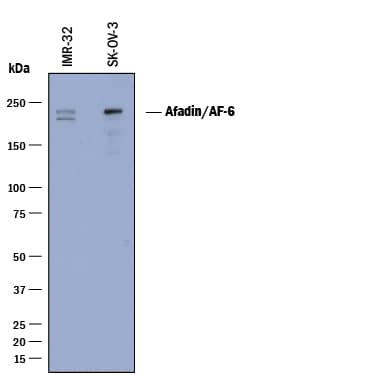Human Afadin/AF-6 Antibody
R&D Systems, part of Bio-Techne | Catalog # MAB78291

Key Product Details
Species Reactivity
Applications
Label
Antibody Source
Product Specifications
Immunogen
Asn217-Pro392
Accession # P55196
Specificity
Clonality
Host
Isotype
Scientific Data Images for Human Afadin/AF-6 Antibody
Detection of Human Afadin/AF-6 by Western Blot.
Western blot shows lysates of IMR-32 human neuroblastoma cell line and SK-OV-3 human ovarian adenocarcinoma cell line. PVDF membrane was probed with 0.5 µg/mL of Mouse Anti-Human Afadin/AF-6 Monoclonal Antibody (Catalog # MAB78291) followed by HRP-conjugated Anti-Mouse IgG Secondary Antibody (Catalog # HAF018). A specific band was detected for Afadin/AF-6 at approximately 200-240 kDa (as indicated). This experiment was conducted under reducing conditions and using Immunoblot Buffer Group 1.Afadin/AF-6 in BEAS2B Human Cell Line.
Afadin/AF-6 was detected in immersion fixed BEAS2B human bronchial epithelial cell line using Mouse Anti-Human Afadin/AF-6 Monoclonal Antibody (Catalog # MAB78291) at 25 µg/mL for 3 hours at room temperature. Cells were stained using the NorthernLights™ 557-conjugated Anti-Mouse IgG Secondary Antibody (red; Catalog # NL007) and counterstained with DAPI (blue). Specific staining was localized to plasma membrane. View our protocol for Fluorescent ICC Staining of Cells on Coverslips.Applications for Human Afadin/AF-6 Antibody
Immunocytochemistry
Sample: Immersion fixed BEAS2B human bronchial epithelial cell line
Western Blot
Sample: IMR‑32 human neuroblastoma cell line and SK‑OV‑3 human ovarian adenocarcinoma cell line
Formulation, Preparation, and Storage
Purification
Reconstitution
Formulation
Shipping
Stability & Storage
- 12 months from date of receipt, -20 to -70 °C as supplied.
- 1 month, 2 to 8 °C under sterile conditions after reconstitution.
- 6 months, -20 to -70 °C under sterile conditions after reconstitution.
Background: Afadin/AF-6
Afadin, also known as MLLT-4 (Myeloid/Lymphoid or mixed-lineage Leukemia Translocated to Ch 4) and AF-6, is a 200-210 kDa nectin and F-actin-binding intracellular protein. It is ubiquitously expressed, and serves as an intermediary that links nectin with the actin cytoskeleton in tight and adherens junctions (AJs). Afadin is involved in the nectin-mediated recruitment of catenins to zonule adherens complexes, and in the recruitment of ZO-1 to the apical side of AJs for the purpose of forming tight junctions. Human Afadin is 1824 amino acids (aa) in length. The protein contains two Ras-association (RA) domains (aa 20-348), a phosphoprotein FHA domain (aa 426‑492), a Vav2 Ras-activating "dilute" domain (aa 668-908), one PDZ domain that binds protein C-termini (aa 1007-1093), and three proline-rich regions (aa 1346‑1708). There are at least fourteen utilized Ser/Thr phosphorylation sites and two Tyr phosphorylation sites. There are at least seven alternative splice variants are reported for Afadin. There is a 190 kDa isoform that shows a 12 aa insert after Arg1605 coupled to a four aa substitution for aa 1650-1824. Other isoforms contain scattered deletions of one to three aa coupled to major aa changes. Five isoforms share a deletion of aa 393-407, with four of these containing a 24 aa substitution for aa 1605-1824, a 73 aa substitution for aa 1747-1824, an 11 aa substitution for aa 680-1824, and a deletion of aa 1683-1746, respectively. A final isoform possesses a four aa substitution for aa 1650-1824. Over aa 217-392, human Afadin shares 94% aa sequence identity with mouse Afadin.
Alternate Names
Gene Symbol
UniProt
Additional Afadin/AF-6 Products
Product Documents for Human Afadin/AF-6 Antibody
Product Specific Notices for Human Afadin/AF-6 Antibody
For research use only

